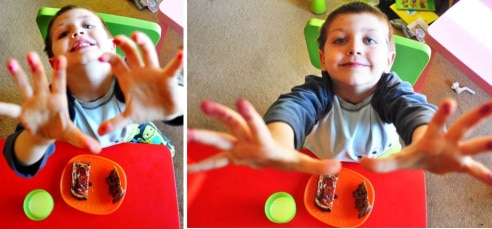
I’d guess that just about everyone has a special comfort food in their list of favorite things. When you think of that favorite bite or catch that familiar aroma, brain activity ignites in a flood of evoked memories, thoughts and experiences.1 My youngest child is only four, but I’m pretty sure that when he grows up, cinnamon raisin toast with strawberry jam will be near the top of his comfort food list. He loves the stuff… could eat it morning, noon and night. One of his other peculiarities is that he has a pristine sense of hand hygiene. I suppose there are much worse compulsions one might have, it’s just that a drive to preserve hand cleanliness doesn’t mix well with an equally powerful drive to consume vast quantities of cinnamon raisin toast with strawberry jam. On days when things became particularly messy, he would throw his hands up in surrender, momentarily forfeiting his toast to get an assist in cleaning his hands. In those instances we would both yell out, “Captain Sticky Fingers!”
Last year Laura Gallagher and colleagues published a paper on the use of metaphor as a powerful tool to reconceptualize pain and minimize catastrophizing in individuals with chronic pain.2 In their randomized crossover trial, they compared two types of interventions using educational booklets. The booklet for the experimental group was designed using stories and metaphors to convey key concepts of pain neurobiology.3, 4 The control group used a booklet containing pain management advice modeled upon recognized cognitive behavioral concepts. Essentially, they found that the group which received pain neuroscience education via story and metaphor was more successful in changing pain knowledge and beliefs, as well as decreasing catastrophizing. It is not too surprising that storytelling emerged as more effective in changing knowledge and beliefs than the advice method. The use of story and narrative are likely some of the oldest forms of communication and education.5 Across the world and throughout history, storytelling has been used to pass on oral traditions between generations, and convey meaning in diverse cultures, societies and religions. Everyone knows the beckoning call of a good story, and good stories are built to be remembered, built to stick with you… they are “sticky”.
Sticky stories and sticky metaphors have not only the capacity to empower and heal, but the power for destruction and harm.6, 7, 8 Any clinician can echo back the powerfully sticky labels which haunt their owners for years… the “ruptured disc”, the “bone on bone” arthritis, or one of my favorites, the “dissolving knee”.
Lately, I find myself searching for the right sticky story, metaphor, slogan or heuristic to rise above other competing narratives in the lives of the folks I see in the clinic. Sometimes, with careful listening the proper stories emerge. Other times, it is a struggle to find the right words and I wish I had Captain Sticky Fingers to come to my rescue. However, when the right story finds the right person at the right time… the results can be remarkable.
What are some of your favorite sticky stories and metaphors for use in explaining pain?
-Steve Schmidt
www.noigroup.com
- Gottfried JA et al. Remembrance of odors past: human olfactory cortex in cross-modal recognition memory. Neuron. 2004; 42(4):687-95.
- Gallagher L, McAuley J, Moseley GL. A randomized-controlled trial of using a book of metaphors to reconceptualize pain and decrease catastrophizing in people with chronic pain. Clin J Pain. 2013; 29(1):20-5.
- Nicholas M, Siddal P, Tonkin L, et al. Manage Your Pain. Sydney: ABC Books; 2002.
- Roland M, Dixon M. Randomized controlled trial of an educational booklet for patients presenting with back pain in general practice. J Roy Coll Gen Pract. 1989;39:244–246.
- Hsu J. The secrets of storytelling: our love for telling tales reveals the workings of the mind. Scientific American. 2008; 19:46-51.
- Richer M, et al. Do words hurt? Brain activation during the processing of pain-related words. Pain. 2010; 148: 198-205.
- Benedetti F, Lanotte M, Lopiano L and Colloca L. When words are painful: unraveling the mechanisms of the nocebo effect. Neuroscience. 2007; 147:260-271.
- Wilson D, Williams M, Butler D. Language and the pain experience. Physiother. Res. Int. 2009; 14(1):56-65.

Dear Steve,
You have said it all so well. The true art of communication is the ability to find-invent the right story for the right person…..
Many Thanks
David
Hi Steve,
“Sticky” is of course a great metaphor to explain how a story/word/image becomes “anchored” in the brain. The conceptual change theorists would refer to it as “elaborated” ie the story is “elaborated” throughout the brain. I find “sticky”to be more evocative than the older and rather mechanistic “neurones that fire together wire together”.TYou could say to a patient on their next visit …”anything sticky about that story I told you last time”
Like many readers,I have collected heaps of potentiallly sticky metaphors. as a starter – the injured disc as a flat tyre i.e implicitly saying it can be pumped up, likes movement, repairable, hasn’t gone anywhere etc. etc.
David